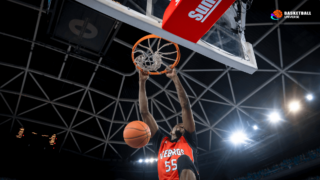
Basketball Time Limit Rule: Managing Game Time
Written by: Basketball Universe
Last updated:

Welcome to the world of basketball, where the fast pace, the buzzer-beaters, and the time limit on each possession make the game thrilling and engaging. Have you ever wondered how time is managed in basketball to deliver such an action-packed show? You’ve come to the right place! In this blog post, we’ll delve into the fascinating subject of ‘Basketball Time Limit Rule: Managing Game Time’, exploring the mechanisms, techniques, and history that come together to create a perfectly timed spectacle. So, fasten your sneakers and let’s set the (shot) clock ticking!
Basketball Time Limit Rule: Managing Game Time
The Basketball Time Limit Rule primarily revolves around the shot clock, which is designed to prevent slow play and maintain a high-paced, engaging game. Each possession has a specific time limit for teams to attempt a shot. In the NBA, this time limit is 24 seconds, while in FIBA and NCAA play, it is 30 seconds for women and 20 seconds for men. The clock resets when the ball hits the rim or if the opposing team gains possession. Additionally, there are other time constraints within a game, such as timeouts, quarter and halftime breaks, and the 5-second inbound rule, all contributing to the overall management of game time.
Understanding Shot Clocks and Time Limits
The shot clock’s primary role is to keep basketball games exciting and fast-paced, ensuring a continuous flow of play. Here, we’ll dive deeper into the intricacies of the shot clock, its history, and how it has evolved over the years. Remember, knowing the basketball rules and time limits within a game is essential for players, coaches, and fans alike.
The Shot Clock’s Origin Story
Once upon a time, in 1954, the NBA faced a major challenge: low-scoring and drawn-out games that were losing fan interest. This problem led to the creation of the 24-second shot clock we know today. Danny Biasone, owner of the Syracuse Nationals, and Leo Ferris, the team’s general manager, calculated that the average number of shots per game at 120 per team. They divided the game’s total seconds (48 minutes or 2,880 seconds) by the average shots (120) to determine a 24-second time limit for each team’s possession. Little did they know that their brilliant idea would become such an integral part of basketball rules and revolutionize the game forever!
Shot Clock Evolution and Variations
The 24-second shot clock proved to be a game-changer, but different leagues worldwide have adapted it to their own needs. For instance, the FIBA and NCAA have opted for a 30-second shot clock in women’s games and a 20-second shot clock in men’s games. In any case, the shot clock serves to maintain the game’s high-octane nature, ensuring fans are drawn to the court’s edge.
Timeouts: Halting the Clock
Timeouts are a crucial part of basketball time management, with each team allotted a specific number of timeouts per game. These breaks provide valuable opportunities for coaches to re-strategize and address players’ needs. Let’s break down how timeouts work and how they can impact a basketball game.
Regular and Shortened Timeouts
Regular timeouts in the NBA last 100 seconds, while shortened timeouts are 60 seconds long. In FIBA games, timeouts last 60 seconds. Coaches can use these moments to make strategic adjustments, discuss plays, and address player performance. Importantly, each league and level of play have different rules for the number and types of timeouts permitted, so always make sure to familiarize yourself with the specific basketball rules of your league.
Managing Timeouts wisely
Coaches should be mindful when using timeouts, as their allocation varies depending on the game’s quarter and league. Timeouts shouldn’t be wasted, as they can significantly influence the game’s outcome, especially during high-pressure situations. Maintaining a smart timeout strategy helps teams stay on top of their game and even turn the tide in their favor.
Breaking it Down: Game Time Division
The division of time in basketball is based around quarters and breaks, with each serving a different purpose. Here, we’ll look at the various divisions of game time, how they’re managed, and how they affect a game’s overall pace.
Quarters: A Game’s Core Structure
All levels of basketball play have a game structure divided into quarters, each of which is responsible for keeping the game orderly and well-timed. In the NBA and FIBA, each quarter lasts 12 minutes, whereas NCAA games allot 10 minutes per quarter for women and two 20-minute halves for men. Understanding these time divisions is crucial to executing effective game strategies.
Halftime: A Well-deserved Break
The halftime break separates a game into two halves, providing teams an extended rest period to reset and recharge. In the NBA and most professional leagues, halftime lasts for 15 minutes, while NCAA games have a 20-minute break. Coaches can use this time to analyze the first half, make roster changes, and plan for the upcoming quarters. It’s important to remember that halftime is more than just a break – it’s a strategic tool for both teams.
Five-Second Rule: Under Pressure
The five-second rule is another essential part of basketball time management that could lead to turnovers if not carefully followed. Let’s take a closer look at how this rule affects inbound plays and dribbling actions.
Inbound Pressure: Watch that Clock!
When inbounding the ball after a made basket, violation, or foul, players must be aware of the five-second rule, which stipulates that they have only five seconds to pass the ball to one of their teammates on the court. Exceeding this time limit results in a turnover, with the opposing team gaining possession. This rule adds urgency to the inbounding play and ensures that the game moves at a consistent pace.
The Five-Second Dribbling Rule
Often called the “closely guarded rule,” this five-second regulation applies to players who dribble the ball while being closely defended in the frontcourt. If a defender maintains close proximity to the offensive player for five consecutive seconds and the offensive player does not attempt a shot, the ref will call a turnover. This rule creates an exciting battle for possession and offensive opportunities, as offensive players must act quickly to elude their defenders.
Bonus Basketball: Meet the Overtime!
What happens when a game is tied at the end of regulation play? We venture into the exciting realm of overtime! Here, we’ll explore the ins and outs of overtime rules and the strategies involved in this bonus basketball period.
Overtime Rules and Strategies
In the NBA, FIBA, and NCAA games, if the teams are tied at the end of the final quarter, the game enters an overtime period. NBA and FIBA overtime periods last 5 minutes, while NCAA overtime periods span 5 minutes for women and men.During the overtime period, teams have additional timeouts and can commit more fouls before entering the penalty. If the game is still tied after the first overtime period, additional overtime periods will be played until a winner emerges. The intensity and pressure ramp up during the overtime, making for heart-stopping, memorable moments.
Managing Time in Overtime
Time management is critical during the overtime period. Using timeouts effectively, making smart shot clock decisions, and being wary of the five-second rules are all vital components of a successful overtime strategy. Composure and well-executed game plans can determine the victor in a nail-biting, neck-and-neck overtime showdown!
High-stakes Action: The Last Two Minutes
Let’s face it, the last two minutes of a close game are some of the most thrilling and nerve-wracking moments in basketball. In this section, we’ll discuss the strategies, tactics, and special rules pertaining to the final minutes of the game.
Clutch Time: Strategies to Close the Game
Effective time management during a game’s final minutes can make the difference between victory and defeat. Coaches and players must be in sync to execute crunch-time strategies, such as picking the appropriate moments to call timeouts or intentionally fouling the opposing team to halt the clock. This strategically calculated game within a game offers dramatic finishes, showcasing the importance of proper time management on the basketball court.
Adapting to Unique Timing Rules
In the NBA, the final two minutes bring rule changes that impact game time as well, ensuring a thrilling conclusion. For example, the “two-minute rule” allows teams to advance the ball to the frontcourt after calling a timeout, and the shot clock is reset to 14 seconds after an offensive rebound, instead of 24. These rule adjustments ensure fast-paced, high-stakes action right up to the game’s final buzzer.
Let the Clock be Your Ally
Now that we’ve covered the basketball rules related to time management, you should have a better understanding of how each rule contributes to the game’s electrifying pace. Remember, understanding the shot clock, timeout allocation, game division, overtime requirements, and the importance of the final minutes is essential for players and coaches to strategize, perform, and ultimately find success on the court. Embrace these time-centered rules and let the clock become an indispensable part of your game!
Impact of Time Management on Team Dynamics
Great basketball teams understand the critical role time management plays in their overall performance. From orchestrating successful plays to making last-second decisions, a team’s ability to navigate through the game’s time constraints often determines its success. In this section, we’ll explore how effective time management impacts team dynamics both on and off the court.
Establishing a Sense of Urgency
Time management plays a central role in fostering a sense of urgency within a team. Players who can adapt to the game’s time constraints exhibit a heightened level of awareness and focus on the court. This sense of urgency translates to quicker decision-making, faster responses to opponents, and an overall heightened sense of teamwork.
Promoting Collaboration and Communication
Effective time management creates an environment that encourages teamwork and communication. During timeouts, players and coaches have a limited window to discuss tactics, make adjustments, and analyze their opponents. This requirement for rapid information exchange fosters strong communication skills within the team, enabling them to better anticipate each other’s movements and strategies.
Preparing for Pressure Situations
Time management isn’t just about the clock; it’s about how well players can perform under pressure. Practicing high-pressure situations often enables teams to develop mental toughness and composure, further enhancing their performance in clutch moments. This preparation translates into a team that’s better equipped to make educated decisions on the fly, making the most of every second they have to compete.
Time Management Tips for Players and Coaches
Understanding the importance of time management in basketball is just the first step. Implementing effective strategies to maximize every second on the court is crucial for both players and coaches. In this section, we’ll share some useful tips to elevate your time management skills in basketball.
Acknowledging the Game Clock
Players must consistently be aware of the game clock to make educated decisions during plays. Not only does this include the shot clock, but also the remaining time in each quarter or half. Knowing how much time is left can dictate the speed and aggressiveness of a team’s approach, leading to strategic advantages.
Practicing Time-Sensitive Scenarios
Coaches can implement time-sensitive scenarios in practice to help players become accustomed to working under pressure. Setting up drills that simulate last-second shots, inbound plays with tight time limits, and other time-bound situations will develop a players’ ability to manage pressure and make decisions in real game-time situations.
Being Mindful of Timeouts
Coaches should always be cognizant of the number and duration of timeouts they have remaining in each game. Effectively using timeouts to rest players, adjust strategies, and boost morale can turn the tide in pivotal moments. Educate your team on the importance of smart timeout management and practice making the most of these brief, game-changing breaks.
Mastering Pacing and Tempo
Finally, understanding the impact of pacing and tempo on the game is essential for both players and coaches. Adjusting pace based on remaining time, a team’s fatigue, and the opposition’s style of play is a valuable skill. Mastering this delicate balance helps dictate the rhythm of the game and ultimately plays a significant role in achieving success on the court.
With a comprehensive understanding of basketball’s time management rules and techniques, both players and coaches will be better equipped to make the most of every second on the court. Implement these strategies into your regular gameplay to elevate your team’s performance, and you’ll uncover the key to unlocking the game’s true potential.
Frequently Asked Questions on Basketball Time Limits
Here, you’ll find a selection of commonly asked questions surrounding time limits in basketball games. We’ve provided clear and concise answers to help clarify any concerns you may have about this exciting aspect of the sport.
1. What is the purpose of the shot clock in basketball?
The shot clock serves as a time limit within which a team must attempt a field goal. It was introduced to prevent slow gameplay and ensure an engaging, fast-paced experience for both players and fans.
2. How long is the shot clock in different basketball leagues?
In the NBA, the shot clock is set at 24 seconds, while FIBA and the NCAA use a 30-second shot clock for women’s games and a 20-second shot clock for men’s games. Different leagues have adapted the shot clock to suit their style of play and competitive level.
3. How many timeouts are allowed in a basketball game?
The number of timeouts per game varies depending on the league. In the NBA, teams are allowed six full (100-second) timeouts and two shortened (60-second) timeouts. In FIBA games, teams receive two timeouts in the first half and three in the second half, each lasting 60 seconds. In NCAA games, teams have four 30-second timeouts and one 60-second timeout.
4. How long are quarters in different basketball leagues?
In the NBA and FIBA, each quarter lasts 12 minutes. In NCAA play, women’s games have 10-minute quarters, while men’s games are divided into two 20-minute halves.
5. What are the time limits for a player to inbound the ball?
Players have five seconds to inbound the ball after a made basket, violation, or foul. If they exceed this time limit, possession is given to the opposing team.
6. In basketball, what is the overtime period’s duration, and how many are possible?
In the NBA, FIBA, and NCAA games, teams play an additional five-minute overtime period in the event of a tie at the end of regulation. If a game remains tied after overtime, additional overtime periods are played until a winner emerges.
7. What is the “two-minute rule” in the NBA?
The two-minute rule in the NBA refers to rule adjustments in the last two minutes of a game. For example, teams can advance the ball to the frontcourt after calling a timeout, and the shot clock is reset to 14 seconds instead of 24 after an offensive rebound.
8. How many fouls can a team commit in overtime before entering the penalty?
In the NBA and FIBA, teams are allowed two team fouls before entering the penalty phase in each overtime period. In NCAA games, teams start with a clean slate in each overtime, and four team fouls are permitted before entering the penalty.
9. What are some ways to manage time during critical late-game situations?
Ways to manage time during late-game situations include calling strategic timeouts, intentionally fouling the opposing team to stop the clock, and executing plays with a strong sense of urgency.
10. How does time management affect team performance and development?
Effective time management contributes to a team’s overall performance by fostering a sense of urgency, encouraging communication, and improving decision-making under pressure. This ultimately leads to a more cohesive and adaptable team on the court.
Featured Posts
- No pillar pages found.





